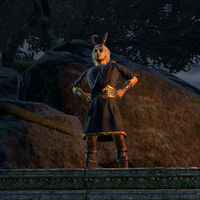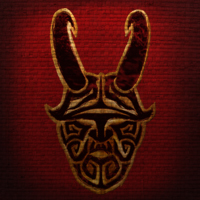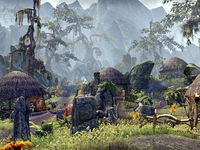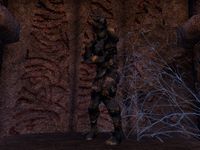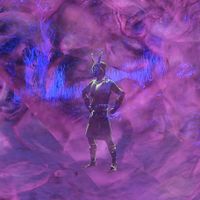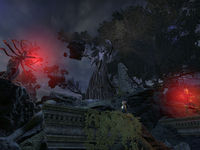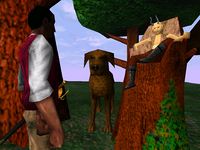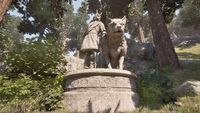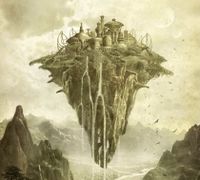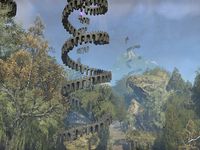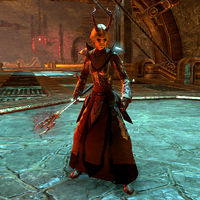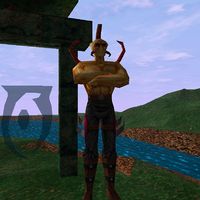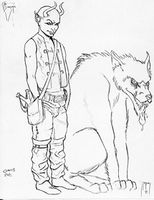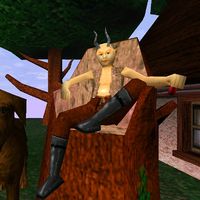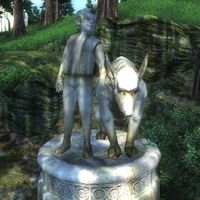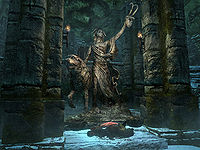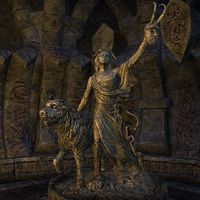Lore:Clavicus Vile
—Clavicus Vile[1]
Clavicus Vile, also known as the Prince of Trickery and Bargains, the Consummate Politician of Oblivion,[2] the Master of Insidious Wishes,[3]:293 and Child-god of the Morningstar,[UOL 1] is a Daedric Prince whose sphere is the granting of power and wishes through ritual invocations and pacts.[4] He is seen as one of the more "sophisticated" of the Daedric Princes,[5] and often appears in the guise of a jovial Skaafin,[6][7][8] a race of horned Daedra that inhabit the Fields of Regret, his realm in Oblivion.[9]
Clavicus Vile is also known as Nycot. According to some, this name was created by the mortal Nycotic Cult, who didn't have the knowledge to properly read the Daedric alphabet, misreading the first five letters of Vile's Daedric name as "Nycot" upon mistaking the runes for Tamrielic letters.[10] However, the name was used by a Skaafin to refer to Vile over three hundred years before the cult's prominence.[11]
Clavicus finds eternity to be "boring", so he finds entertainment in watching mortals and occasionally meddling in their affairs.[1] He has been known to be the patron to vampires, gracing them with social stature, reason and savvy, allowing them to not only live among regular mortals, but to hold powerful positions in society.[12] However, not all of Vile's machinations are necessarily insidious; he has been known to reward those who, on his direction, eliminate threats to the general public (while still serving his own interests).[13]
Vile is rarely seen without his loyal companion, Barbas.[14] Barbas typically assumes the form of a dog,[14][15] but is also known to appear as a Scamp named Creeper.[16][17] The two are so close, Barbas is almost universally depicted alongside his master in artwork and statuary.[14][18] In fact, Vile has been known to store up to half his power within Barbas.[19] These facts have led to speculation that the pair are, in fact, two halves of the same being, as Vile's very social nature would not allow him to exist without a companion.[14]
It is said Clavicus Vile is the most carefully neutral Daedric Prince,[2] though he as at times created alliances, such as his role in The Triad.[20] He is an enemy of Ebonarm.[21] Clavicus Vile's summoning day coincides with the New Life Festival, the 1st of Morning Star.[22]
According to some sources Vile views himself as a playful and fun-loving god who basks in the sun alongside his favorite companion, Barbas. This mindset is said to be reflected in the idyllic form his realm takes, making his domain less a normal place like one would find on Nirn and more a "state of mind". Despite this view of himself Vile's "games" are noted to often be dangerous, making caution necessary when approaching him.[23]
Religion and Culture[edit]
The Cyrodiil Vampyrum Order attributes their success and social stature to Clavicus Vile. They believe their bond with Vile is what makes them unique amongst vampires, as his guidance steels their craving for blood with reason and savvy. Thus the Order reveres Clavicus Vile as one of their Dual Patrons, the other being Molag Bal who they call "Kin-Father", and revere as the original source of vampirism itself.[12]
Some sources claim that Clavicus Vile and Sanguine are not popular Princes among the Reachmen.[5]
History[edit]
The Sload necromancer N'Gasta claims that Clavicus Vile was born before the stars were, and that his name preceded, and therefore inspired, the concepts it connotes.[24] Some of the earliest evidence of Clavicus Vile's comes in the form of ancient idols and cave paintings dating back to the Merethic Era. They depict Clavicus Vile standing with Barbas by his side.[14] Ancient Kothringi were believed to venerate Clavicus Vile in early Merethic Era, prior to reform in their religion and turning to worship Z'en.[25]
Second Era[edit]
Before the Interregnum[edit]
In the sixth century, at the height of the Knahaten Flu within Black Marsh, the Kothringi people were on the verge of extinction. In a desperate effort to save themselves, a singular tribe in Northern Shadowfen turned to the Daedra for help. Clavicus Vile offered to save their tribe at the cost of their mortality, and they accepted; surviving, but becoming undead unable to die. They would continue their way of life until 582, when the Vestige discovered the truth of the tribe and was given a choice by Clavicus Vile; They could break the curse and kill the last of the Kothringi, including those who wanted to continue living, or they could doom the rest of the unwilling Kothringi to continue their suffering forevermore. Which fate the Vestige picked for the Kothringi is unknown.[26][27][28]
During the Interregnum[edit]
In 2E 582, a novice Altmer mage named Pircalmo was hired by the Bosmer inhabitants of Willowgrove to clear the nearby forest. However, Pircalmo's ability with magic was limited by his constant mistakes. Before attempting to cast his spell, the mage wished for it to "work well". Unbeknownst to him, his wish was granted by Vile, who had an ancient and forgotten altar inside a nearby cavern. Pircalmo's spell "worked" in that it summoned a horde of dangerous atronachs to burn down the forest. Having seemingly failed the contract, Pircalmo's wife was duly taken by the local Bosmer to be killed and eaten. Fortunately, the Vestige discovered the altar, which Barbas had been inexplicably bound to due to the mage's wish. The Vestige then smashed the altar, freeing Barbas and dispelling the atronachs before Pircalmo's wife could be harmed.[29][30][31] That same year, Barbas appeared as Creeper when an Orc merchant named Zagrugh summoned a scamp to act as his assistant. Zagrugh ran a general store beneath the city of Mournhold, in a Dunmeri ancestral crypt which had been taken over by outlaws. He had hoped that a summoned Daedra would be more loyal than his previous assistants, who had all stolen from him.[32] Mysteriously, Zagrugh was later found dead, and Creeper stepped in to manage the store.[33][34][32]
At one point in time, a previous owner of the Vassir-Didanat Ebony Mine in the Ascadian Isles region of Vvardenfell had erected a shrine to Clavicus Vile and made a deal with him, unsatisfied with the mine's Ebony production. The owner requested a limitless supply of Ebony, and Vile provided them a formula that would achieve this, an alchemical concoction which functioned by transforming the flesh of an unfortunate mortal into a form of False Ebony.[35] This substance, dubbed "False Ebony", looks and feels like real Ebony, but can be told apart by a skilled craftsman.[36]
Circa 2E 582, the mine passed into the ownership of Rethan brothers of House Hlaalu, who decided to hire an alchemist by the name of Gavros to further research the formula. He subjected many of the miners to the formula, discovering that "blood pressure must remain consistent until the last possible moment". His final breakthrough involved turning the formula from liquid to solid based, making the process much faster, but it came with the caveat of turning the victims of the experiments feral.[37] With a vapor based formula perfected, and its ability to make its victims feral creatures that would eventually degrade into statues, Gavros hypothesized that vapor-based False Ebony could be used as an airborne alchemical weapon.[36] Unfortunately for him, the breakthrough proved to be too effective, and he was exposed to it when it got loose, leaving him to the same fate that he subjected his victims to.[38]
The Vestige was hired to investigate the rumored curse of the mine, and discovered the feral victims that now populated it. There, they recovered Vile's foul formula, and Balmora's Hlaalu Councilor requested it remain within the Houses hands, but it is unknown if the adventurer complied.[39]
The Triad[edit]
At some point in the Early Second Era, Clavicus Vile formed a secretive alliance known only as 'The Triad', pacting with two other princes, Mephala and Nocturnal. Their goal was to acquire the means to remake reality by any means possible.[40] Their first known target was the mythical Crystal Tower on Summerset. As part of their scheme, Clavicus Vile made a deal with the Sea Sloads of Ul'vor Kus—he would give them the island of Summerset in exchange for a piece of Transparent Law, the 'Stone' of the Crystal Tower. The Cabal of Sea Sloads brainwashed the Ritemaster of the Psijic Order, Iachesis, into stealing Transparent Law, but Nocturnal secretly betrayed Clavicus Vile and Mephala and helped Iachesis hide the Stone from the rest of the Triad, providing him with a spell that would hide the Heart from everyone, until such time as she could move forward with her own plans. Iachesis then moved the island of Artaeum off of Nirn entirely to avoid falling under the influence of the Princes yet again. With the Triad's plan seemingly foiled, they moved on and began to plot their next move.[20][41] As part of the Triad's deal with the Sea Sload, they promised them the island of Summerset itself in exchange for the Heart, something which would've been achieved through the Abyssal Geysers activated by the followers of the Princes, the Court of Bedlam, that were intended to sink the island into the sea.[42][43][44][45][46]
Following this, the Triad found that their next target would be the fabled Clockwork City. While the Triad began their attempts to locate it, with Barbas enacting his own plan in an attempt to please his master. Barbas began tampering with the construction of Vivec City. He was noticed by Archcanon Tarvus of the Tribunal Temple, who saw evidence of sabotage and had planned to tell Vivec of the potential canine culprit he spotted.[47] According to Barbas himself, he found that Tarvus had passed in his sleep, and at that point decided to impersonate him.[48][31]
Concurrently, the Nycotic Cult was somehow able to acquire the artifact known as Sunna'rah, a staff that was created by the Tribunal God Sotha Sil as a tool for him to experiment with his own powers.[49] Conoon Chodala, the Ashkhan of the Urshilaku Tribe, discovered through a benefactor about the staff and wished for it to be acquired, with the Ashlander later offering a proposal to the Red Exiles who were sent by him in order to retrieve the staff from the cult, but not before the cultists first prepared a ritual that was able to allow the object to channel unfathomable power, with the plan calling for the exiles to let the cultists start the ritual but not allow it to be finished.[50][48]
After Chodala was killed by the Vestige and the staff was returned, Barbas still posing as Archcanon Tarvus, used it to steal Vivec's divine energy and discover the Clockwork City's location. He succeeded, and Barbas entered the City to arrange Clavicus Vile's arrival, but was stopped by the Vestige and the mage Barilzar, who pursued him into the City.[51][52] The Vestige found themselves transported to the shrine of Clavicus Vile, where the Prince threatened to imprison them. However they channeled the power of Vivec contained within Sunna'rah against the Prince through his statue, allowing them to escape. Thus Vivec's stolen energy returned seconds before Baar Dau crashed into Vivec City. Had this plot not been foiled this would have caused great devastation to Vvardenfell. Barbas nevertheless succeeded in locating the Clockwork City for his master Clavicus Vile.[48][53][54][31]
Now knowing how to enter the Clockwork City, the Triad quickly launched a full-scale coup within it. Nocturnal replaced Sotha Sil with a shadowy replica and imprisoned the Clockwork God within his own throne. Meanwhile, one of the Clockwork Apostles, Chancellor Gascone Dusant, sought to deliver the Skeleton Key, which had been accidentally found by a Factotum beneath the Brass Fortress, to Clavicus Vile, only for the Key to be stolen by the Blackfeather Court. The Vestige, assisted by Divayth Fyr and the Clockwork Apostles, unveiled the plot, but were unable to reclaim the Skeleton Key before it was taken by Sotha Sil's Shadow. Using the key, Nocturnal and the Shadow attempted to seize control of the Clockwork City by unlocking the Throne itself, but were stopped by the Vestige, Divayth Fyr, and Proctor Luciana Pullo, who rescued Sotha Sil by defeating his Shadow and repelling Nocturnal's darkness through a special light spell Sotha Sil had once taught Luciana. Once freed Sotha Sil banished Nocturnal's shadow from the Clockwork City. Sotha Sil then gave the Skeleton Key to Divayth Fyr for safekeeping. In reality, however, Nocturnal had tricked Clavicus Vile and Mephala once more and succeeded in stealing crucial information for the final part of her plan.[55][54][56]
The Triad turned their attention once more to the Crystal Tower following this failure, seeking some way to find the missing Heart of Transparent Law or otherwise gain entrance to the Tower. Clavicus Vile would send the Abyssal Cabal to Summerset once more, to work with his agents in the Court of Bedlam in an attempt to hunt down Iachesis and pull the location from his mind. In preparation for the completion of their plan, the Triad invaded Meridia's realm, the Colored Rooms, and she was imprisoned within Nocturnal's darkness to prevent her from interfering further.[57][58] This chase would eventually lead into Nocturnal's realm, Evergloam, where her treachery was revealed and it was discovered that the Heart was hidden within Iachesis himself. Clavicus Vile and Mephala both immediately manifested within the realm to claim it, only for Nocturnal to banish them both and rip it out of the Ritemaster herself. With the Heart, Nocturnal briefly took control of the Crystal Tower, hoping to use its properties of existing in every reality simultaneously, enhanced by the life force of Nirn which she'd drain through the use of a secret life draining technique she'd stolen from Sotha Sil's Clockwork City, to achieve omnipresence in the entire Aurbis. In this manner she'd absorb the power of the other Daedric Princes as she invaded their realms, thus gaining infinite power through the infinite connections made, and ultimately unravel reality itself to wait for the next one to arise. Nocturnal's shadow enveloped the Tower and transformed the Sapiarchs inside into shadows, while she attempted to repair Transparent Law by reconnecting it with its Heart, making the Tower whole to complete her plan.[41][54][40] At the same time, her forces started invading the realms of the other Princes.[31]
Clavicus Vile begrudgingly allied himself with the Psijic Order and the Vestige in order to stop her, granting them access to the Crystal Tower's counterpart in his own realm and having Barbas lead the charge against Nocturnal's invading forces, though not before extracting the promise of a favor at some unspecified point in the future from the Vestige. After the Vestige succeeded in finally putting a stop to Nocturnal's plot, Clavicus Vile joined the Coldharbour Compact alongside Mephala and disbanded the Triad for good.[20][31][59][53]
As of the 2E 582, Jovial Lambasters, a cult of Clavicus Vile were among the most powerful factions in Rimmen.[60][61][7]
After the Interregnum[edit]
—Clavicus Vile to Cyrus[1]
After slaying the necromancer N'Gasta, who was an acolyte of Vile, the famed hero Cyrus the Redguard ventured into Clavicus Vile's realm in 2E 864, seeking the soul of his sister, Iszara. Vile kindly gave him an opportunity to have it—the two gambled, the Prince wagering Iszara's soul, and Cyrus wagering his own. [62][63]
Third Era[edit]
Around 3E 405, an agent of the Blades working in the Iliac Bay region summoned Clavicus Vile. The Prince agreed to give the agent the Masque of Clavicus Vile in exchange for killing a werewolf that was terrorizing the area.[6]
The Bittercup, a relic associated with the Prince became the focus of a Thieves Guild operation in Vvardenfell in 3E 427.[64] The Nerevarine retrieved the artifact from the ruins of Ald Redaynia and used it to bribe Eydis Fire-Eye, a member of the Balmora Fighters Guild and secret worshipper of Clavicus Vile.[64][65]
The Nerevarine also came into possession of the legendary sword Umbra, by defeating its previous owner, an Orc named Umbra, who had grown tired of life.[66] The Nerevarine later sold the sword to Torasa Aram, curator of Mournhold's Museum of Artifacts.[67]
Umbra resurfaced in Cyrodiil in 3E 433. Vile tasked the Hero of Kvatch with retrieving the sword from a Bosmer named Umbra, in exchange for his Masque. However, Barbas attempted to dissuade the Hero from doing so, saying the sword was "bad business" and if Clavicus regained the sword it would "ruin him".[68] It is unclear whether or not the Hero returned the sword, but it was known to be in the Prince's possession a few years later.[68][69]
Fourth Era[edit]
Umbriel Crisis[edit]
Clavicus Vile played a role in the creation of the Ingenium during the early days of the Fourth Era. The device's purpose was to hold Baar Dau over Vivec City after the disappearance of Vivec. It functioned by creating a rift to the Fields of Regret through which souls were funneled to Clavicus Vile, and the energies of the realm were leeched to hold the moon in place. The mage Sul, who was one of the designers of Ingenium, theorized that the Daedric Prince did not care for the stolen energies as he valued the souls he received in exchange more, and that the other architect of the project, Vuhon, might have even made a formal pact with Vile for him to allow the energies to be taken.[70] This process started by using the souls of prisoners and undesirables, which resulted in their immediate deaths. Eventually, a method was found that let souls power the Ingenium without causing immediate death. When Sul's lover, Ilzheven, was taken to power the Ingenium, he destroyed it in an attempt to save her. This caused Baar Dau to crash into Vivec City, resulting in the eruption of Red Mountain and the destruction of Vvardenfell and part of mainland Morrowind, an event that became known as the Red Year. The event also resulted in Vuhon and Sul falling through the rift and into the realm of Clavicus Vile.[69]
The floating island, Umbriel, appeared in the skies of Tamriel In 4E 48. It was a chunk of Clavicus Vile's realm of Oblivion, torn away by the Dunmer Vuhon and his new ingenium with the aid of Umbra. Seeking to retrieve Umbra, Vile made the dimensional walls of his realm impermeable to prevent escape, but Vuhon and Umbra used the Second Ingenium to circumvent his circumscription and twist part of the realm away.[69] The pocket realm was eventually summoned to Nirn by Hierem and the An-Xileel through a ritual involving the Mad Hist of Lilmoth. This event became known as the Umbriel Crisis. This not only significantly impacted Tamriel, but also greatly weakened Clavicus Vile, to the point that his Daedric Realm only measured a few miles across.[71]
Eventually Sul and Attrebus Mede found themselves in the Fields of Regret. Within the disintegrating realm, they met Clavicus Vile and Barbas. The pair attempted to bargain with the Prince for his aid in reaching Umbriel, offering up the husk of the Umbra Sword, now empty of the spirit within, in exchange. Vile initially refused, claiming that he'd remained as powerful as ever by spreading himself less thin, that Umbra was nothing but an aspect of his with delusions of being its own person, that he had other followers that could retrieve Umbra, and that he'd only offer aid in exchange for one of their souls. However, Attrebus pointed out that Umbriel was making its way to the Imperial City in order to reach the White-Gold Tower, the power of which could be used to make Umbra truly independent from Vile. Forced to concede, Vile agreed to help. He could not transport the two to Umbriel directly, as Vuhon had made it so the island was invisible to him, but he could take them to the Imperial City, where the island was headed. Before transporting them to their destination, Vile warned that they'd come to regret their deal by the end.[71]
In the end, the pair reached Umbriel, and managed to separate Vuhon and Umbra, imprisoning the spirit within the blade once more. It was than that Vile manifested, by possessing Attrebus himself per the terms of their deal. The Prince stabbed Sul with the Umbra Sword, but the Dunmer managed to grab the blade and fell back into the Ingenium as Vile's laughter echoed in his ears. Sul, the Umbra Sword, and the Ingenium than dissolved into a wave of black smoke, which reformed itself into a giant avatar of Clavicus Vile. The still living Vuhon informed the now freed Attrebus that Vile likely intended to drain the souls of everyone remaining on Umbriel before letting it drop onto the Imperial City itself. The only hope was to have the Umbriel-Hist banish Vile and Umbriel with the aid of Mere-Glim, who could help due to now being part of the island. Vuhon still retained the power he originally had, something which Vile could not take, and so he distracted the Prince long enough for the Hist and Mere-Glim to complete the banishment.[71] Thus Vile was able to regain the power he lost due to the crisis, seemingly reclaiming the spirit of Umbra and absorbing the thousands of souls within Umbriel's Ingenium in the process, but failing to carry out his plan to unleash more chaos in Tamriel. [69][71]
Temporary Separation from Barbas[edit]
In 4E 201, Barbas approached the Last Dragonborn outside of Falkreath in Skyrim for help. He and Clavicus had gotten into a heated argument, and the Prince kicked Barbas out until he could get someone to settle things. However with Barbas holding half of Clavicus Vile's power, this weakened the Daedric Prince to the point of being incapable of exerting influence outside the immediate vicinity of his shrine. Barbas led the Dragonborn to a vampire-infested shrine in the cavern of Haemar's Shame to reunite with his master. After killing the vampires (who were seeking a cure, inadvertently granted), Vile asked the Dragonborn to retrieve an artifact, the Rueful Axe. Upon returning with the axe, Vile offered to let the Dragonborn keep it in exchange for killing Barbas, allowing him to absorb Barbas' spirit and regain his full power without having to listen to his voice, while Barbas suggested the Dragonborn ask the Prince to take him back and receive the Masque of Clavicus Vile instead. It is unknown which choice the Dragonborn made in the end but, either way, Clavicus Vile was reunited with the portion of his power embodied by Barbas.[72]
In late 4E 179, the Umbra Sword mysteriously returned to the affairs of mortals when an Imperial treasure hunter named Cresitus fell down a hole in the mountains east of Shor's Stone in Skyrim and broke both of his legs. He found himself within the long-lost crypts known as Champion's Rest, an ancient Nordic ruin once used to as a gladiatorial arena. Stranded and dying, Cresitus began to dream that he was swimming in a sea of black, with the Umbra Sword calling out for him to claim it. He awoke to find the sword next to him; his legs immediately began to heal, as if by magic. Over the next several days, Umbra began to whisper to Cresitus in his sleep, hungering for souls. Eventually, Cresitus set up camp and gave up any plans to escape the ruin, finding himself content among the restless souls of so many fallen warriors. His psyche fused with the sword, and, donning a set of ebony armor, Cresitus began to call himself Umbra.[73] He remained undisturbed for many years, until circa 4E 201 when silver prospectors from Shor's Stone broke through into Champion's Rest and encountered an armored "ghost" wielding a whispering sword. This ghost was in fact a soul image of Umbra, a physical manifestation which he could split from his person at will.[74]
Other Affairs[edit]
Circa 4E 201, a Nord mage named Rulnik Wind-Strider came upon a mysterious altar at the Roadside Ruins north of Falkreath. There, he met an old woman who appeared to be its keeper. She explained that he needed to choose a bowl from the altar: the first would grant him power, the second would bring him fortune, and the third would offer nothing at all.[75] Stricken with ataxia, Rulnik continued on his journey after this encounter, but ended up in the care of the Temple of Kynareth in Whiterun.[76] The Last Dragonborn subsequently came across the same altar by following Rulnik's trail, although it is unknown which bowl was chosen or whether Rulink's illness was cured. Regardless, the Dragonborn was given the Bittercup by Clavicus Vile as a reward for having made a choice.[76][77]
Champion's Rest was subsequently investigated by the Vigil of Stendarr, who correctly surmised that the Umbra Sword—thought to have been destroyed—was the only Daedric artifact which matched the miners' description.[74] Hearing rumors of the ruin's discovery, the Last Dragonborn arrived at Champion's Rest and entered the draugr-filled ruin to put a stop to Umbra before he could threaten Shor's Stone. Umbra and his soul images faced the Dragonborn in the ancient Nordic arena, possessing powerful magic and physical immunities, but the Dragonborn was successful in killing Cresitus and claiming the sword to prevent it from falling into the wrong hands.[78]
Artifacts[edit]
Bittercup[edit]
The Bittercup (or Bitter Cup) is an artifact sacred to Clavicus Vile, the Daedric Prince of Bargains. It is prized by the Daedra Lord's followers. Only the strongest of the Emperor's servants are advised to make covenant with Prince Clavicus, and even then are warned against sipping from the Bittercup.
Masque of Clavicus Vile[edit]
The Masque of Clavicus Vile (also known as The Masque of Clavicus or Mask of Clavicus Vile) is a helm which makes the wearer more popular wherever they might go by making them seem charming and trustworthy. Much like other Daedra and their artifacts, Clavicus seems to retain ultimate control of the Masque and may recall it without warning.
The best known story of the Masque tells the tale of Avalea, a noblewoman of some renown. As a young girl, she was grossly disfigured by a spiteful servant. Avalea made a dark deal with Clavicus Vile and received the Masque in return. Though the Masque did not change her looks, suddenly she had the respect and admiration of everyone. A year and a day after her marriage to a well connected baron, Clavicus Vile reclaimed the Masque. Although pregnant with his child, Avalea was banished from the Baron's household. Twenty-one years and one day later, Avalea's daughter claimed her vengeance by slaying the Baron.
Umbra[edit]
The Umbra Sword (or simply Umbra) is a Daedric artifact designed with the sole purpose of the entrapment of souls. Sometime before 2E 582, the ancient witch Naenra Waerr created the sword at the request of Clavicus Vile, who wanted the sword as a tool of mischief which would send him souls from the mortal realm. Naenra created the sword but it was unstable, requiring Vile to give the witch a piece of his power to be imbued in the sword in order to stabilize it. However, Naenra (sometimes accredited with being Sheogorath in disguise) supposedly tricked him, as the piece of Vile's power imbued in the sword became a sentient being which called itself Umbra. Naenra was executed for her evil creation, but not before she hid the sword. The sword took on a life of its own, remaining hidden until a worthy wielder was found. Umbra then slowly takes control of the wielder. The Umbra Sword has the ability to change shape, but it is always in the form of a bladed weapon. It has been reported as a black and silver claymore, a jet black longsword and as a black sword emblazoned with red markings. The sword is also known to have the ability to absorb the health and stamina of those it strikes.
The Rueful Axe[edit]
The Rueful Axe is a Daedric artifact created by the Daedric Prince, Clavicus Vile, as part of a terrible bargain. It takes the form of a large iron battleaxe engraved with images of werewolves, although it is actually made of ebony. It is enchanted to steal the strength of anything it strikes, as well as a bane for beasts.
Feyfolken[edit]
Feyfolken is a (possibly fictional) artifact of Clavicus Vile, which is the subject of a historical fiction book. It is a quill enchanted with the soul of a Daedric servant of Clavicus Vile named Feyfolken, at the request of Thaurbad, a sage for the Temple of Auri-El.[79] It transfigures the writing of the user into scripture of unparalleled quality.[80] The trade-off of wielding such an item is that the quill manipulates the thoughts of its holder. In the case of Thaurbad, he was driven to suicide, even writing notes to whoever would discover his body.[81]
The Monochrome Paintbrush[edit]
The Monochrome Paintbrush is a cursed artifact held within the Psijic Order's Vault of Moawita. According to a tale recounting the relic's origin, there once was an artist of great talent that lived in the Summerset Isles. She tried to paint vibrant scenes, but found common colors lacking and incapable of truly bringing her visions to life. In her hour of desperation, an old merchant appeared, with no companion save the hound by his side. The merchant offered the artist a large paintbrush, with a white tip and a black ivory handle, claiming it would truly bring life into her work. The artist accepted the gift and went to work. To her amazement, the brush worked, what had been mere paint just moments before became sparkling and shining, with depths yet unknown. It went beyond color and emotion and transcended anything she had seen before, finally bringing her vision to life. Yet, as she painted, the color began to fade from her lips, the tips of her fingers, and the point of her nose. Her hair turned from a golden yellow to a faded white, her clothes lost their blue and purples and turned to shades of gray. She did not notice, however, and kept painting until her whole body was in shades of black and white, her eyes grew heavy, and her heart slowed, until she collapsed. Before the dead artist's body was the most beautiful painting in the history of Summerset, which would go on display from than on, but not on Nirn.[82]
Fields of Regret[edit]
The Fields of Regret are a realm of Oblivion, created and ruled over by Clavicus Vile, the Daedric Prince of Wishes. The realm appears as a tranquil countryside, dotted with majestic cities of glass and ornate buildings and populated by Skaafin. It contains dense forests, lakes, and mountains, with floating golden metals and stone spirals filling the landscape. The city of Umbriel was once a part of the realm, but was eventually severed and came to rest in the Realm of the Hist.
According to some sources, the Fields of Regret are not a place in the same sense that a place on Nirn is, rather the realm is a "state of mind", specifically the state of mind of Clavicus Vile, which reflects on the realm and causes everything there to be exactly as Vile wishes it to be. Thus its form is said to represent Vile's mindset, a green, sunny and pleasant land interspersed with tranquil ponds under an expanse of clear blue sky, reflecting Vile's view of himself as a playful and fun-loving god who basks alongside his companion, Barbas, the pleasant appearance concealing Vile's true temperament which is likened to that of a child cruelly playing with insects.
Servants[edit]
Clavicus Vile's servants include the Skaafin,[9] and Guardians.[83] The Prince has also been known to summon Atronachs while fulfilling wishes.[31][29][30]
Gallery[edit]
A statue of Clavicus Vile ESO
Notes[edit]
- In Lord of Souls, Hierem planned to use the power of the White-Gold Tower to siphon the thousands of souls within Umbriel's Ingenium, as he believed their power would allow him to achieve Apotheosis and become a god. At the end of the Umbriel Crisis, the Ingenium and its souls alongside the Umbra Sword and Sul came together to form Clavicus Vile's physical body. As he was already a god, it is unclear what effect this might've had on Vile.[71]
See Also[edit]
- For game-specific information, see the Daggerfall, Redguard, Oblivion, Skyrim, and Elder Scrolls Online articles.
Books[edit]
- Feyfolken by Waughin Jarth — The Great Sage tells a story of Artaeum, Psijics, and Robotic Enchanters
- The Nycotic Cult by Ordinator Alurua of the Order of Doctrine and Ordination — An Ordinator's letter regarding Clavicus Vile cultists
- The Vile Truth of Barbas From the notes of Pelagius Habor, Council Daedrologist-in-Residence, Imperial City — A scholarly essay on the relationship between Clavicus Vile and Barbas
References[edit]
- ^ a b c Clavicus Vile's dialogue in Redguard
- ^ a b NPC dialogue about Clavicus Vile in Daggerfall
- ^ The Elder Scrolls V: Skyrim: Prima Official Game Guide — David Hodgson
- ^ The Book of Daedra
- ^ a b Loremaster's Archive: Arthenice Belloq Answers Your Questions — Arthenice Belloq
- ^ a b Clavicus Vile's appearance in Daggerfall
- ^ a b Clavicus Vile's appearance in Redguard
- ^ Clavicus Vile's Appearance in ESO
- ^ a b Events of ESO
- ^ The Nycotic Cult — Ordinator Alurua of the Order of Doctrine and Ordination
- ^ Archmagister Mavon's Ascension — Nardhil Arethan
- ^ a b Manifesto Cyrodiil Vampyrum
- ^ Events of Daggerfall
- ^ a b c d e The Vile Truth of Barbas — Pelagius Habor, Council Daedrologist-in-Residence, Imperial City
- ^ Barbas' appearance in Skyrim
- ^ Events of Morrowind
- ^ Barbas' dialogue in Oblivion
- ^ Clavicus Vile's statue in Skyrim
- ^ Clavicus Vile's dialogue in Skyrim
- ^ a b c Events of ESO: Summerset
- ^ Factions in Daggerfall
- ^ New Life Festival description in Daggerfall
- ^ pg.175 of The Redguard Companion
- ^ N'Gasta's dialogue in Redguard
- ^ Silver Wish Medallion antiquity codex text
- ^ Events of ESO
- ^ Events of The Thin Ones ESO
- ^ Events of The The Bargain's End ESO
- ^ a b Pircalmo's dialogue in ESO
- ^ a b Questionable Contract quest in ESO
- ^ a b c d e f Barbas's dialogue in ESO
- ^ a b Zagrugh's Journal — Zagrugh
- ^ Zagrugh in ESO
- ^ Creeper in ESO
- ^ The Source of the Formula — Gavros
- ^ a b Gavros's Journal — Gavros
- ^ Gavros's Research Notes — Gavros
- ^ Gavros' dialogue in ESO
- ^ Events of Like Blood from a Stone in ESO
- ^ a b Leythen's dialogue in ESO
- ^ a b Ritemaster Iachesis' dialogue in ESO: Summerset
- ^ Battlereeve Tanerline's dialogue in ESO: Summerset
- ^ K'Tora's dialogue in ESO: Summerset
- ^ Indirim's Journal, Assembled — Indirim
- ^ Grog's dialogue in ESO: Summerset
- ^ Sinking Summerset quest in ESO: Summerset
- ^ Archcanon's Journal — Tarvus, Archcanon to the Lord Vivec
- ^ a b c Events of ESO: Morrowind
- ^ Barilzar's dialogue in ESO: Morrowind
- ^ Red Exile Instructions — Chodala
- ^ Events of Divine Intervention in ESO: Morrowind
- ^ Events of Divine Restoration in ESO: Morrowind
- ^ a b Clavicus Vile's dialogue in ESO
- ^ a b c Sotha Sil's dialogue in ESO
- ^ Events of ESO: Clockwork City
- ^ Shadow of Sotha Sil's dialogue in ESO
- ^ Meridia's dialogue in ESO
- ^ Nocturnal's dialogue in ESO
- ^ Mephala's dialogue in ESO
- ^ Persistence of Daedric Veneration — Lady Cinnabar of Taneth
- ^ Ferrus Mallon's dialogue in ESO
- ^ Events of Redguard
- ^ N'Gasta's dialogue in Redguard
- ^ a b Events of the Bitter Cup quest in Morrowind
- ^ Gentleman Jim Stacey's dialogue in Morrowind
- ^ Events of the Umbra quest in Morrowind
- ^ Events of Morrowind: Tribunal
- ^ a b Events of Oblivion
- ^ a b c d Events of The Infernal City
- ^ Pages 257-258 of The Infernal City
- ^ a b c d e Lord of Souls — Greg Keyes
- ^ Events of A Daedra's Best Friend quest in Skyrim
- ^ Treasure Hunter's Journal — Cresitus
- ^ a b Vigilant's Report
- ^ Mysterious Altar — Rulnik Wind-Strider
- ^ a b A Dying Wish quest from the Bittercup Creation for Skyrim
- ^ On the Bittercup — CV
- ^ Vile Whispers quest in Skyrim
- ^ Feyfolken I — Waughin Jarth
- ^ Feyfolken II — Waughin Jarth
- ^ Feyfolken III — Waughin Jarth
- ^ The Monochrome Paintbrush — Author Unknown
- ^ Guardians during Rescue Iszara in Redguard
Note: The following references are considered to be unofficial sources. They are included to round off this article and may not be authoritative or conclusive.
| ||||||||
| |||||
